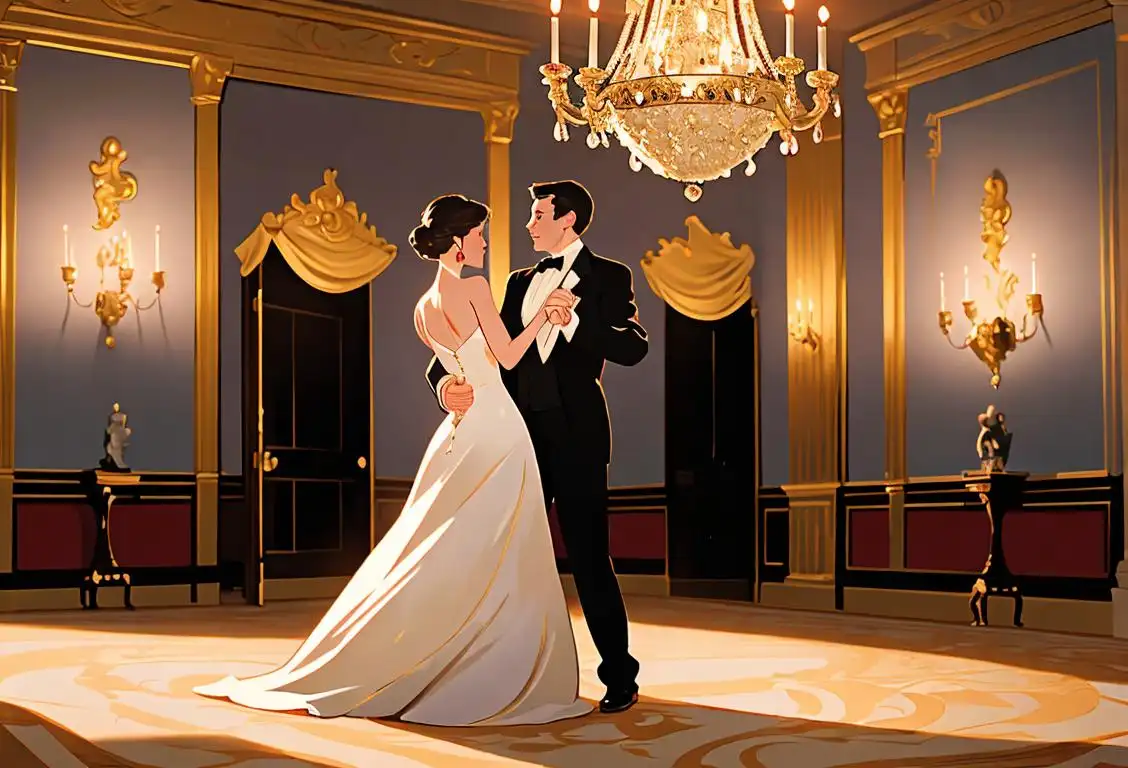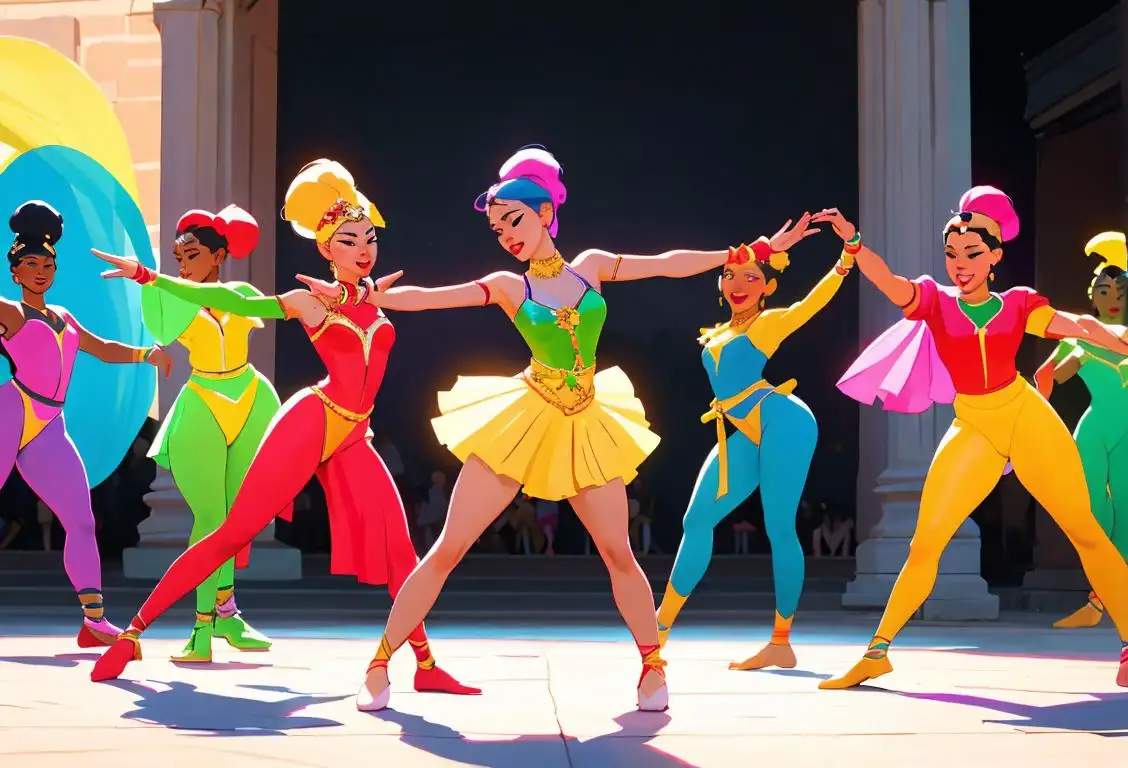National Dance The Waltz Day

Welcome to WhatNationalDayIsIt.com, where we dig deep into the history and significance of national days! Today, we shine the spotlight on National Waltz Day, a celebration of the elegant and graceful dance. Join us as we waltz through the pages of history and uncover the secrets of this enchanting form of movement!
When is Dance The Waltz Day?
It's national dance the waltz day on the 4th March.
Dancing Back in Time
The waltz, with its smooth glides and sweeping turns, has captivated dancers for centuries. It originated in the ballrooms of Europe, particularly in Germany and Austria, during the late 18th century. At that time, formal dances were dominated by rigid patterns and steps, but the waltz revolutionized the dance floor with its breathtaking grace and close embrace.
The waltz quickly gained popularity among both the upper classes and common folk. However, it wasn't all smooth sailing for this charming dance. Some conservative circles viewed the waltz as scandalous due to its close contact between partners. Nevertheless, the allure of the waltz persisted, and it continued to capture the hearts of dancers worldwide.
A Waltz Through the Internet
The internet has played a significant role in keeping the waltz alive and kicking. With the rise of video sharing platforms, aspiring dancers can now learn the waltz from the comfort of their own homes. Countless tutorial videos, step-by-step guides, and online classes have made waltz accessible to people of all ages and abilities. So if you've always dreamed of gliding across the dance floor like a pro, the internet is here to make your waltzing dreams come true!
Celebrating National Waltz Day
On National Waltz Day, dance enthusiasts and novices alike come together to celebrate the beauty and elegance of the waltz. Whether you're attending a formal ball or simply swaying in your living room, this day is all about embracing the joy of movement and losing yourself in the music.
Grab a partner—or dance solo if you prefer—and let the waltz transport you to a world of sophistication and romance. Don your finest attire, choose a beautiful waltz tune, and let the rhythm guide your feet as you twirl across the dance floor. Don't worry if you're a beginner; the waltz is all about enjoying the journey and savoring every step.
History behind the term 'Dance The Waltz'
1780
Development of the Waltz
In the late 18th century, a new style of dance called the waltz emerged. Originating in Central Europe, particularly Vienna, Austria, it quickly gained popularity among the aristocracy. The waltz featured a unique 3/4 time signature and a close, intimate hold between partners, distinguishing it from other dances of the time.
1780
Origin of the waltz
The waltz is believed to have originated in the late 18th century. Its roots can be traced back to the folk dances of Bavaria, Germany. The term 'waltz' (from the German word 'Walzer') initially referred to a dance in triple time. However, the waltz as we know it today only started to take shape in this period. It was considered controversial at the time due to its close hold and rotating steps, which were considered scandalous by some conservative members of society.
1787
The Birth of the Waltz
The term 'dance the waltz' originates from the birth of the waltz dance in 1787. It was first introduced in Vienna, Austria and quickly gained popularity across Europe. The waltz was unique because it incorporated a new dance position where the partners embraced each other closely, a departure from the more traditional dance positions of the time.
1780
The emergence of the waltz
The term 'dance the waltz' originates during the late 18th century, around the year 1780. It marks the emergence of a new dance style that gained popularity in the German-speaking regions of Europe. The waltz was a lively and elegant dance performed in 3/4 time, characterized by smooth turns and fluid movements. Initially, it was considered quite scandalous due to its close hold and intimate nature compared to traditional ballroom dances.
1771
The Birth of the Waltz
The term 'dance the waltz' originated in 1771, when a new dance style called the waltz first emerged in the suburbs of Vienna, Austria. The waltz was especially popular amongst the lower classes and was characterized by its 3/4 time signature and a close hold between the dancers. However, at this time, it was considered scandalous due to the physical contact between partners, which was unorthodox in formal dance settings.
1771
The Birth of the Waltz
The term 'dance the waltz' originated in 1771 when a German composer and dancer named Johann Gottfried Kleist introduced a new dance style called the waltz. Kleist's waltz featured a unique turning movement, where partners would rotate in a closed position. This marked the birth of the waltz dance.
1812
Waltz Gains Popularity
In 1812, the waltz gained immense popularity when it was introduced to high society in Vienna. The dance was showcased at a grand ball attended by European aristocrats, including Napoleon Bonaparte. The waltz's graceful movements and enchanting music captivated the upper classes, and it quickly became a social sensation across Europe.
1812
Controversial in Court
In 1812, the waltz gained popularity in both England and Vienna. However, its reputation was far from favorable. Many considered the dance scandalous due to its close contact between dancers. Despite the controversy, the waltz continued to grow in popularity, especially among the younger generation.
1812
Introduction to English Society
The waltz made its way to England in 1812 and was initially met with resistance. It was considered scandalous and immoral due to the close contact between partners. However, a turning point came when the Prince Regent, later King George IV, embraced the waltz. His endorsement led to its acceptance in English high society.
1802
Waltz Controversy
In 1802, the waltz faced significant controversy and criticism due to its close embrace and the spinning movements involved. The dance was seen as scandalous and improper, particularly by the higher classes who viewed it as indecent and shocking. However, this controversy only served to increase its popularity among the rebellious and the younger generation.
1802
Johann Strauss and the Viennese Waltz
In the year 1802, composer and musician Johann Strauss Sr. elevated the status of the waltz by introducing the Viennese Waltz. This refined version of the dance gained immense popularity in Vienna and soon made its way to the rest of Europe. The Viennese Waltz became an integral part of social events and balls, bringing a sense of elegance and sophistication to the dance.
1813
Vienna's waltz craze
The waltz gained popularity and recognition in Vienna, Austria during the early 19th century. In 1813, Johann Strauss Senior, a Viennese composer, wrote his first waltz music, which added to the growing popularity of the dance. It soon became a hit at various balls and parties across Vienna. The elegance and grace of the waltz captured the hearts of many, making it a cherished symbol of the Viennese cultural heritage.
1812
Waltz conquers Paris
In 1812, the waltz reached Paris and quickly captivated the French society. Its energetic and graceful movements attracted both high society and the common folk. The dance gained further recognition when Napoleon Bonaparte himself embraced it and danced the waltz with his second wife, Marie-Louise of Austria, at their wedding reception. This endorsement by the French imperial couple solidified the waltz's place in European culture.
1833
Waltz Spreads to England
By 1833, the waltz had made its way to England, where it faced initial resistance due to its association with social immorality. However, the dance gradually gained acceptance within British society, with major influence from the Viennese waltz style. It became an essential part of ballroom dancing and was further refined to suit the English taste.
1816
Waltzing with Style
By the 1810s, the waltz had evolved both in steps and technique. Choreographers like Carlo Blasis and Jean-Baptiste Gourdoux developed refined forms of waltzing that included elegant turns, spins, and graceful movements across the dance floor. These innovations added to the allure and appeal of the dance.
1812
Waltzing in Society
By 1812, despite the initial backlash, the waltz had firmly established itself in society. The dance had spread throughout Europe and was now widely accepted as a popular social dance. Not only was it enjoyed at grand balls and soirées, but it also became a fixture in the everyday lives of people from various social backgrounds.
1819
Spread of the waltz
The waltz quickly spread beyond Vienna, reaching other European countries. With its rise in popularity, dance schools and instructors began teaching the waltz to eager learners. This led to the dissemination of waltz techniques and styles, further fueling its cultural impact. As the dance grew in popularity, it underwent slight modifications and variations to suit regional preferences and traditions, giving rise to different waltz styles across Europe.
1830
Waltz Comes to America
By the 1830s, the waltz had made its way across the Atlantic to the United States. It was introduced in society balls and dance halls, captivating Americans with its lively rhythms and graceful movements. The waltz quickly became a fashionable dance and a symbol of elegance and romance.
19th Century
Waltz in the 19th century ballrooms
During the 19th century, the waltz became a prominent feature of ballrooms across Europe. Its popularity transcended social classes, and people enthusiastically embraced the dance. With the spread of sheet music and dance manuals, more individuals learned to dance the waltz, making it an essential part of social gatherings and celebrations.
19th century
Waltz in ballrooms and opera houses
During the 19th century, the waltz became a staple dance in ballrooms, opera houses, and social gatherings. Its captivating melodies and graceful movements attracted people from various social classes. It was not only a popular social dance but also found its way into ballroom competitions and performances. Choreographers and dancers continuously refined the waltz, incorporating more intricate steps and patterns to display their skills and creativity.
1825
Waltz Becomes Sensational
In 1825, the waltz reached new heights of popularity when Johann Strauss I composed his first waltz, 'Tales from the Vienna Woods.' This composition, along with subsequent waltzes by Strauss and other composers, helped solidify the waltz's position as the quintessential dance of the Romantic era. The waltz became synonymous with elegance, grace, and romance, captivating dancers and audiences alike.
1893
Viennese Waltz Takeover
In 1893, the Viennese Waltz, a faster-paced version of the traditional waltz, gained popularity. Originating in Vienna, Austria, this new style featured quicker steps and intricate turns. The Viennese Waltz became a sensation and remains one of the most recognizable waltz variations to this day.
1844
Waltz Comes to America
In 1844, the waltz arrived in America, primarily through immigrants from Europe. Initially, it faced opposition and criticism similar to its early days in England, as American society considered it scandalous and inappropriate. However, the waltz slowly gained popularity over time and became a fixture in American ballrooms and social events.
1847
Waltzing in Ballrooms Worldwide
In the mid-19th century, the waltz had spread to ballrooms across Europe and the United States. It became a staple dance at social events and gained recognition as a symbol of grace and elegance. The waltz also influenced the development of other partner dances, influencing the way people danced for generations to come.
20th Century
Evolution of Waltz Styles
Throughout the 20th century, the waltz continued to evolve and adapt to various regional styles and musical influences. It underwent transformations such as the introduction of faster tempo, inclusion of spins and turns, and incorporation of different cultural dance elements. Today, the waltz remains an iconic and widely recognized dance form, practiced and enjoyed by people around the world.
1910
Modern Influence of the Waltz
Throughout the 20th century, the waltz continued to maintain its influence on dance and music. The introduction of new dance styles and genres didn't diminish its charm. The waltz, with its flowing movements and beautiful melodies, influenced various dance forms, such as the Viennese waltz, ballroom waltz, and even contemporary dance. Its timeless grace and enchanting rhythms have ensured its longevity as a beloved dance through the years.
20th century
Waltz in popular culture
Throughout the 20th century, the waltz maintained its popularity and continued to influence popular culture. It was featured in numerous films, stage productions, and even modern dance shows. The waltz remains an essential part of traditional ballroom dancing, with competitions and exhibitions dedicated to the dance style. Its enduring appeal and timeless beauty make it a cherished dance form that transcends generations.
1910
Waltz in the Ballroom
During the 1910s, the waltz became a staple in ballroom dancing. It was taught in dance schools and performed at grand balls worldwide. The dance's flowing movements and enchanting music made it a favorite among dancing enthusiasts and social elites alike.
20th Century
Waltz in popular culture
In the 20th century, the waltz continued to evolve and gained prominence in various artistic mediums. Composers like Johann Strauss Jr., Pyotr Ilyich Tchaikovsky, and Maurice Ravel incorporated waltz melodies into their compositions, immortalizing the dance in classical music. Furthermore, the waltz found its place in films, with iconic scenes featuring this elegant dance form. Its timeless appeal and universal recognition have cemented the waltz's cultural significance to this day.
20th Century
Waltz in Popular Culture
Throughout the 20th century, the waltz continued to captivate audiences and permeated popular culture. It was featured in numerous films, musicals, and ballets, showcasing its enduring charm. The waltz also made its way into the world of competitive ballroom dancing, with dedicated competitions and championships showcasing the mastery of this dance form.
Did you know?
Did you know that the waltz was once considered scandalous? In the early 19th century, some European authorities denounced the dance for its close contact between partners. Thankfully, the waltz prevailed and is now celebrated as a beautiful art form!Tagged
romance funFirst identified
4th March 2016Most mentioned on
4th March 2016Total mentions
10Other days
Tv On The Same Day
Do Something Nice Day
Honesty Day
Iloveyou Day
Kiss A Ginger Day
Happiness Day
Dance Day
Compliment Day
Single Ppl Day
Suicide Prevention Month Day









